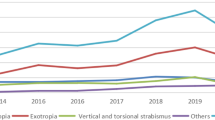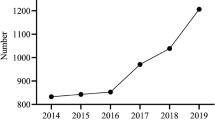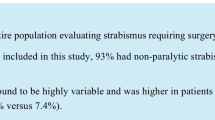Abstract
Objective
This study aimed to analyze the distribution of different types of strabismus surgery in a tertiary hospital in Central China during the three-year period of the COVID-19 pandemic.
Methods
A retrospective analysis was conducted on the clinical data of strabismus patients who underwent surgery and were admitted to the Department of Strabismus and Pediatric Ophthalmology at the First Affiliated Hospital of Zhengzhou University between January 2020 and December 2022.
Results
A total of 3939 strabismus surgery patients were collected, including 1357 in 2020, 1451 in 2021, and 1131 in 2022. The number of surgeries decreased significantly in February 2020, August 2021, and November and December 2022. Patients aged 0–6 years accounted for 37% of the total number of strabismus surgery patientsr. The majority (60%) of all strabismus surgery patients were diagnosed with exotropia, with intermittent exotropia accounting for the highest proportion (53%). There was no statistically significant difference in the proportion of intermittent exotropia and constant exotropia during the three-year period (χ2 = 2.642, P = 0.267 and χ2 = 3.012, P = 0.221, respectively). Among patients with intermittent exotropia, insufficient convergence type was the most common form of strabismus (accounting for over 70%). Non-accommodative esotropia accounted for more than 50% of all internal strabismus cases.
Conclusion
During the period from 2020 to 2022, the total number of strabismus surgeries in our hospital did not show significant fluctuations, but there was a noticeable decrease in the number of surgeries during months affected by the pandemic. Exotropia accounted for the highest proportion among strabismus surgery patients. Intermittent exotropia was the most common type among patients undergoing surgery for exotropia, and the most prevalent subtype was the insufficient convergence type. The age distribution of patients varied in different months, with a concentration of surgeries for strabismus patients in the 7–12 years old age group during the months of July and August each year.
Similar content being viewed by others
Background
Strabismus, a common and prevalent disease in ophthalmology, not only affects the appearance of patients, but also leads to amblyopia, abnormal binocular vision function, and even psychological inferiority. Epidemiological studies in European countries have shown that esotropia is the most common type of strabismus in Europe [1]. Relevant studies have also been conducted in Asian countries, with results showing that exotropia is the most common type in Asian countries [2]. Some regions in China have conducted epidemiological studies on strabismus, with results similar to those in Asian countries [3, 4]. Our hospital is the largest comprehensive hospital in Henan Province, China, with sufficient sources of strabismus and pediatric ophthalmology professional groups. We hope to use statistical analysis of our clinical data to obtain the distribution pattern of various types of strabismus surgery in the Central Plains region of China, in order to provide reference for clinical work.
Methods
Collect clinical data of strabismus patients who underwent surgery by the strabismus and pediatric ophthalmology professional group of the First Affiliated Hospital of Zhengzhou University from January 2020 to December 2022, and carry out statistical analysis. All patient information is extracted from the medical record system, including patient names, gender, age, diagnosis, etc.
All patients underwent refraction, best-corrected visual acuity, anterior segment, fundus, intraocular pressure, and strabismus specialty examinations, including corneal reflection test, prism and alternate cover test, Krimsky test for 33 cm and 6 m strabismus, eye movement, four-point light, binocular vision assessment, and Titmus stereo chart.
All strabismus patients were admitted for surgical treatment after strict screening of surgical indications in the outpatient department. The admission diagnosis was classified according to the Chinese Strabismus Diagnosis Expert Consensus [5].
Statistical analysis: SPSS 27.0 was used for statistical analysis. Chi-square test was used to compare the differences in the proportion of various types of strabismus over the three years. If P < 0.05 in the comparison between the three groups, further pairwise comparisons were conducted.
Results
The total number of strabismus surgeries in 2020 was 1357, in 2021 was 1451, and in 2022 was 1131 (Fig. 1). The surgical volume significantly decreased in February 2020, August 2021, November 2022, and December 2022. Except for special circumstances, July and August are the peak periods for strabismus surgery each year (Table 1; Fig. 2).
When the patients were grouped by age, it was found that patients aged 0–6 years accounted for 37% of the total number of strabismus surgeries, those aged 7–12 years accounted for 31%, those aged 13–18 years accounted for 12%, and those over 18 years accounted for 20% (Table 2; Fig. 3). It was also found that strabismus surgeries for children aged 7–12 were concentrated in June, July, and August of each year (Fig. 4).
From 2020 to 2022, a total of 3939 strabismus surgeries were performed, of which exotropia surgeries were the most common, accounting for 60% (2361 patients); esotropia surgeries accounted for 29% (1146 patients), and the number of exotropia surgeries was about twice that of esotropia surgeries (Table 3). Among exotropia surgeries, intermittent exotropia had the highest proportion, accounting for about 53%, followed by constant exotropia, accounting for about 35%. The proportion of intermittent and constant exotropia did not change significantly over the three years (χ2 = 2.642, P = 0.267 and χ2 = 3.012, P = 0.221, respectively) (Table 4). Among intermittent exotropia, the proportion of convergence insufficiency type was the highest, accounting for more than 70%, while the proportion of separation excess type was the lowest, less than 3% (Table 5). Among esotropia classifications, non-accommodative esotropia had the highest proportion, accounting for more than 50% (Table 6).
Discussion
Over the past three years, the total number of strabismus surgeries performed at our hospital was 1357, 1451, and 1131, respectively, with no significant fluctuations. The surgery volume significantly decreased in February 2020, August 2021, November 2022, and December 2022. Analysis showed that this was due to the severe impact of the COVID-19 epidemic in Zhengzhou during these months. Non-ophthalmic emergency patients did not seek medical attention, resulting in a sharp decline in strabismus surgery during the months with severe epidemics. Foreign studies have also found that during the COVID-19 epidemic, only ophthalmic emergency patients sought medical attention. This is because ophthalmic examinations require face-to-face interaction, which increases the risk of virus transmission, and ophthalmologists are also assigned to care for COVID-19 infected patients [6]. During the epidemic, the total number of strabismus surgeries per year decreased compared to the pre-epidemic period. Before the epidemic, our hospital performed approximately 2000 strabismus surgeries per year, and the epidemic indeed had a significant impact on the total number of surgical patients.
Except for special circumstances, the peak period for strabismus surgery is usually in July and August each year. Statistical analysis of the age distribution of patients showed that strabismus surgery for children aged 7–12 years is concentrated in June, July, and August each year. This is related to the Chinese national conditions, where July and August are summer vacation periods. The majority of strabismus patients are school-age children. To avoid affecting their studies, parents choose longer holidays to allow their children to undergo strabismus surgery. There were no significant differences in this distribution pattern before and after the epidemic. Relevant studies in China have also shown a significant seasonal variation in the number of strabismus patients seeking medical attention, with peak periods during the winter and summer vacations [7, 8].
After grouping the patients by age, it was found that strabismus surgery patients under 18 years old accounted for 80% of the total, indicating that most strabismus patients undergo surgical treatment before adulthood. The purpose of strabismus surgery is not only to improve appearance but also to obtain good binocular visual function. Studies by many scholars in China and abroad have shown that the development of human binocular vision begins in infancy. The sensitive period is from 3 to 5 months after birth, with a peak at 1–3 years old, and development continues until 6–9 years old [9]. Therefore, some scholars suggest that for intermittent or constant exotropia, surgery should be performed before the age of 7 to better restore perceptual function [10]. With the increasing awareness of strabismus and the necessity of strabismus surgery among parents, the window for strabismus surgery has shifted earlier.
In the past three years, exotropia surgery patients accounted for the largest proportion, about 60%, followed by esotropia surgery patients, accounting for about 29%. The number of exotropia surgery patients is about twice as high as that of esotropia surgery patients. Among exotropia surgery patients, the proportion of intermittent exotropia is the highest, about 53%, followed by constant exotropia, accounting for about 35%. Among patients with intermittent exotropia, the proportion of insufficient convergence type is the largest, accounting for over 70%, while the proportion of excessive separation type is the smallest, less than 3%. With the development of China’s economy and health care system, young children can receive early vision screening, such as routine physical examinations in kindergartens. Strabismus patients can be detected early and undergo conservative treatment, such as wearing glasses and vision training. More and more parents can supervise their children to persist in wearing glasses and vision training, which enables some children with accommodative esotropia to restore normal eye position through conservative treatment and avoid surgery. Therefore, exotropia surgery patients are more than esotropia patients, with similar results in many domestic studies. In a retrospective study involving 5,746 strabismus patients, found that exotropia surgery accounted for 63.5% of cases, esotropia surgery accounted for 13.2% of cases, and intermittent exotropia was the most common subtype within exotropia surgery, accounting for approximately 71.3% [11]. However, the primary subtype in intermittent exotropia was different from our study’s findings. In a study of 4,640 strabismus surgery patients, reported that exotropia surgery accounted for 54% of cases, esotropia accounted for 22.1% of cases, and constant exotropia was the most common type within exotropia, although its prevalence decreased over the years [4]. Intermittent exotropia was the next most common type and showed an increasing trend. A study conducted in Singapore on a Chinese population also indicated a ratio of 7:1 for exotropia to esotropia, with the majority of exotropia cases being intermittent (63%). In a study of 12,327 strabismus surgery patients over a 10-year period, found that constant exotropia was the most common type among all subtypes, and the number of exotropia surgery patients was approximately 5.83 times that of esotropia surgery patients [12]. However, a study conducted in a tertiary hospital in Spain over a year and a half period involving 153 patients showed that esotropia accounted for 47.7% of cases, while exotropia accounted for 35.9% [13]. These findings indicate significant differences in the classification of strabismus surgery patients between China and Europe.
During the past three years, the proportion of intermittent exotropia has decreased, and the proportion of constant exotropia has increased, but the difference was not statistically significant (χ2 = 2.642, P = 0.267; χ2 = 3.012, P = 0.221). This may be because the COVID-19 epidemic has limited the medical treatment of patients with intermittent exotropia, and the condition has gradually progressed to constant exotropia. Some studies have shown that one-third of patients with intermittent exotropia experience a deterioration of their condition after a three-year follow-up [14].
This study conducted a statistical analysis of the distribution of strabismus surgery in our hospital during the three-year period of the Covid-19 pandemic. It identified the characteristics of strabismus surgery distribution during the pandemic period. However, there are certain limitations to this study. It is a retrospective analysis that only reflects the results of a specific period and cannot study the overall incidence rate of strabismus. In the future, it is hoped that research with a larger sample size will be conducted to explore the universality of the distribution characteristics of strabismus and the issue of strabismus prevalence in China.
Conclusion
During the three-year period of the Covid-19 pandemic, the total number of strabismus surgeries in our hospital did not show significant fluctuations. The number of strabismus surgeries decreased significantly during the months of the Covid-19 pandemic. Patients under 18 years old accounted for 80% of the strabismus surgeries, and patients between 7 and 12 years old were concentrated in the months of July and August each year. Among all strabismus surgery patients, exotropia was the most common type, occurring twice as often as esotropia. Among patients with exotropia, intermittent exotropia had the highest proportion. The combined proportion of intermittent exotropia and constant exotropia remained stable during the three-year period of the Covid-19 pandemic, but the proportion of intermittent exotropia decreased, while the proportion of constant exotropia increased. This fully demonstrates the importance of early screening and regular follow-up observation for patients with intermittent exotropia, and the need for necessary intervention measures at the appropriate time to prevent the progression of intermittent exotropia to constant exotropia.
Data availability
The datasets generated and/or analysed during the current study are not publicly available due individual privacy but are available from the corresponding author on reasonable request.
References
Fieß A, Elflein HM, Urschitz MS, Pesudovs K, Münzel T, Wild PS, Michal M, Lackner KJ, Pfeiffer N, Nickels S, Schuster AK. Prevalence of Strabismus and its impact on Vision-Related Quality of Life: results from the German Population-based Gutenberg Health Study. Ophthalmology. 2020;127(8):1113–22. https://doi.org/10.1016/j.ophtha.2020.02.026.
McKean-Cowdin R, Cotter SA, Tarczy-Hornoch K, Wen G, Kim J, Borchert M, Varma R, Multi-Ethnic Pediatric Eye Disease Study Group. Prevalence of amblyopia or strabismus in Asian and non-hispanic white preschool children: multi-ethnic pediatric eye disease study. Ophthalmology. 2013;120(10):2117–24. https://doi.org/10.1016/j.ophtha.2013.03.001.
Zhu B, Wang X, Fu L, Yan J. Pattern Strabismus in a Tertiary Hospital in Southern China: a retrospective review. Med (Kaunas Lithuania). 2022;58(8):1018. https://doi.org/10.3390/medicina58081018.
Bi Y, Yam JC, Lin S. A retrospective study of strabismus surgery in a tertiary eye hospital in the Chaoshan area in China from 2014 to 2020. BMC Ophthalmol. 2022;22(1):246. https://doi.org/10.1186/s12886-022-02479-8.
Anonymous. Chinese expert consensus on classification of strabismus. (2015) [J]. Chinese Journal of Ophthalmology. 2015;51(006):408–410. https://doi.org/10.3760/cma.j.issn.0412-4081.2015.06.002.
Tingley J, Tauber J, Thuma T, Moon JY, Barmettler A. Impact of the COVID-19 pandemic on quantity and characteristics of Ophthalmology consults. Telemedicine J e-health: Official J Am Telemedicine Association. 2022;28(10):1547–51. https://doi.org/10.1089/tmj.2021.0512.
Qu Xiaohui L, Weimin Z, Dedong, et al. Seasonal Kendall coefficient analysis of the number of visits by patients with strabismus[J]. Chin J Med Aesthet. 2014;4(5):2.
Hong Y, Baoyi Z. Retrospective analysis of 2100 cases of strabismus surgery[J]. Int J Ophthalmol. 2006;6(3):2. https://doi.org/10.3969/j.issn.1672-5123.2006.03.059.
Helveston EM. 19th annual Frank Costenbader lecture–the origins of congenital esotropia. J Pediatr Ophthalmol Strabismus. 1993;30(4):215–32. https://doi.org/10.3928/0191-3913-19930701-03.
Abroms AD, Mohney BG, Rush DP, Parks MM, Tong PY. Timely surgery in intermittent and constant exotropia for superior sensory outcome. Am J Ophthalmol. 2001;131(1):111–6. https://doi.org/10.1016/s0002-9394(00)00623-1.
Wan X, Wan L, Jiang M, Ding Y, Wang Y, Zhang J. A retrospective survey of strabismus surgery in a tertiary eye center in northern China, 2014–2019. BMC Ophthalmol. 2021;21(1):40. https://doi.org/10.1186/s12886-021-01805-w.
Li JH, Xie WF, Tian JN, Zhang LJ, Cao MM, Wang L. Changing strabismus surgery distribution at Shanxi Province Eye Hospital in Central China. J Pediatr Ophthalmol Strabismus. 2017;54(2):112–6. https://doi.org/10.3928/01913913-20161013-01.
Merino Sanz P, Donoso Torres HE, Gómez de Liaño Sánchez P, Casco Guijarro J. Current trends of strabismus surgery in a tertiary hospital. Tendencias actuales de la cirugía de estrabismo en un hospital terciario. Arch De La Sociedad Esp De Oftalmologia. 2020;95(5):217–22. https://doi.org/10.1016/j.oftal.2020.01.007.
Kwok JJ, Chong GS, Ko ST, Yam JC. The natural course of intermittent Exotropia over a 3-year period and the factors Predicting the Control Deterioration. Sci Rep. 2016;6:27113. https://doi.org/10.1038/srep27113.
Funding
The Provincial-Ministerial Co-construction Project of Medical Science and Technology in Henan Province (No. SB201901013); The Key Basic Research Project of Henan Province Universities (No. 22B320016).
Author information
Authors and Affiliations
Contributions
LLJ is responsible for design course and writing the article. GKX is responsible for data analysis, ZLX is in charge of creating charts and graphs, ZJ, LYJ, RJB, and XLM are responsible for data entry, and LZG is responsible for proofreading the article. All authors have read and provided input. All authors read and approved the final manuscript.
Corresponding author
Ethics declarations
Ethics approval and consent to participate
This study was conducted according to the guidelines of the Declaration of Helsinki and was approved by the Ethics Committee of The First Affiliated Hospital of Zhengzhou University (2023-KY-0992-003,26 October 2023). Informed consent was exempt by the Ethics Committee of The First Affiliated Hospital of Zhengzhou University as it was a retrospective study.
Consent for publication
Not applicable.
Competing interests
The authors declare no competing interests.
Additional information
Publisher’s Note
Springer Nature remains neutral with regard to jurisdictional claims in published maps and institutional affiliations.
Rights and permissions
Open Access This article is licensed under a Creative Commons Attribution 4.0 International License, which permits use, sharing, adaptation, distribution and reproduction in any medium or format, as long as you give appropriate credit to the original author(s) and the source, provide a link to the Creative Commons licence, and indicate if changes were made. The images or other third party material in this article are included in the article’s Creative Commons licence, unless indicated otherwise in a credit line to the material. If material is not included in the article’s Creative Commons licence and your intended use is not permitted by statutory regulation or exceeds the permitted use, you will need to obtain permission directly from the copyright holder. To view a copy of this licence, visit http://creativecommons.org/licenses/by/4.0/. The Creative Commons Public Domain Dedication waiver (http://creativecommons.org/publicdomain/zero/1.0/) applies to the data made available in this article, unless otherwise stated in a credit line to the data.
About this article
Cite this article
Lang, L., Guo, K., Zhang, L. et al. The distribution characteristics of strabismus surgery types in a tertiary hospital in the Central Plains region during the COVID-19 epidemic. BMC Ophthalmol 24, 67 (2024). https://doi.org/10.1186/s12886-024-03327-7
Received:
Accepted:
Published:
DOI: https://doi.org/10.1186/s12886-024-03327-7








